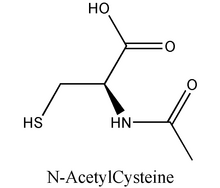Intravascular radiocontrast use can result in contrast nephropathy, which occurs more commonly in patients with diabetes and renal insufficiency. This adverse event rarely results in a need for dialysis but can increase morbidity and mortality and prolong hospital stays. Saline hydration and low-osmolar contrast agents have been shown to reduce the incidence of nephropathy. acetylcysteine (NAC) administration has been associated with decreased adverse events, but the magnitude of the benefit has not been clearly quantitated. Isenbarger and associates reviewed randomized clinical trials of NAC for prevention of contrast nephropathy to assess the degree of benefit.
The study included prospective trials that compared NAC plus saline hydration with saline hydration alone, with and without placebo controls, in patients prepared for angiography or computed tomography. Seven studies were included in the analysis. Non-ionic, low-osmolar contrast material was used in all studies, and the serum creatinine level was measured 48 hours after administration. Contrast nephropathy was defined as an increase in the serum creatinine level of greater than 0.5 mg per dL (44 mmol per L), or greater than 25 percent, from baseline.
The odds of developing contrast nephropathy were significantly lower in patients using NAC before contrast administration. Nine patients would have to be treated with NAC to prevent one episode of nephropathy. This effect was not related to the baseline creatinine level, the contrast volume, or the percentage of patients with diabetes.
The authors conclude that, although the clinical significance of contrast nephropathy is debatable because its impact on mortality is uncertain, administering NAC before contrast material in susceptible patients could decrease the length of hospital stay and prevent chronic worsening of renal function. The use of saline hydration attenuates the perceived benefit of NAC. Because benefits have been observed, and NAC is low in cost and easy to administer, routine prophylactic use of NAC is recommended in patients with stable chronic renal insufficiency or diabetes who are undergoing elective angiography.
RICHARD SADOVSKY, M.D. Isenbarger DW, et al. Meta-analysis of randomized clinical trials on the usefulness of acetylcysteine for prevention of contrast nephropathy. Am J Cardiol December 15, 2003;92:1454-8.
EDITOR'S NOTE: Prevention of contrast nephropathy is a high priority because of the risk of permanently worsened renal function and longer hospital stays. Both acetylcysteine (NAC) and intravenous hydration have proven useful in this setting. Isotonic hydration started before elective or emergency coronary angiography and continued until the next morning reduces the rate of contrast nephropathy. (1) A protocol for intra-venous administration of NAC in patients with chronic stable renal insufficiency who are having coronary intervention with contrast medium demonstrates that 150 mg per kg in 500 mL of normal saline administered over 30 minutes immediately before contrast exposure and 50 mg per kg in 500 mL of saline over the subsequent four hours successfully reduces contrast nephropathy compared with intravenous saline hydration alone. (2) --R.S.
References
(1.) Mueller C, Buerkle G, Buettner HJ, Petersen J, Perruchoud AP, Eriksson U, et al. Prevention of contrast media-associated nephropathy. Randomized comparison of 2 hydration regimens in 1620 patients undergoing coronary angioplasty. Arch Intern Med 2002;162:329-36.
(2.) Baker CS, Wragg A, Kumar S, De Palma R, Baker LR, Knight CJ. A rapid protocol for the prevention of contrast-induced renal dysfunction: the RAPPID study. J Am Coll Cardiol 2003;41:2114-8.
COPYRIGHT 2004 American Academy of Family Physicians
COPYRIGHT 2004 Gale Group



